- Books Name
- ACME SMART COACHING Biology Book
- Publication
- ACME SMART PUBLICATION
- Course
- CBSE Class 11
- Subject
- Biology
ANGIOSPERMS (FLOWERING PLANTS OR ANTHOPHYTES)
Angiosperms-Classification up to Class
After Linnaeus work on classification of plants, the taxonomists realised the necessity of information on natural history of vegetation and the affinities at various levels of hierarchy.
George Bentham and J.D. Hooker gave most important natural system of classification of angiosperms and published it in three volumes of Genera Plantarum.
They described 202 families. In this system, description of plants was based on detailed studies and dissections.
This system is followed in all British Commonwealth countries including India.
The system being handy, it is preferred and used by the students in practical classes. This system covered about ninety seven thousand species of seed plants.
In Bentham and Hooker system of classification, phanerogams were divided into three classes on the basis of morphological characters, such as leaf arrangement and venation pattern, number of members in floral whorls like calyx, corolla, androecium and gynoecium, number of cotyledons in the seed and seeds with or without cover.
In this classification, Class is like division, series is like class, cohort is like order and order is like family.
An outline of the Bentham and Hooker classification of phanerogamia is given below:
Class 1 : Dicotyledonae
General characters
Pentamerous flower, reticulate venation in leaves, two cotyledons in seed, open vascular bundles (with cambium), secondary growth present, wood formation occurs.
It is divided into 3 sub-classes
Sub-class 1 : Polypetalae -Petals free.
It includes three series:
Series 1 : Thalamiflorae -Flower hypogynous, stamens and pistils many (indefinite), petals free, distinct sepals are free from ovary. It has 6 orders, e.g., Ranales, Parietales, Malvales etc.
Series 2 : Disciflorae -Flower hypogynous, Calyx consists of free or united sepals, Petals free, a prominent cushion shaped disc is present below ovary. It has 4 orders, e.g., Sapindales, Geraniales etc.
Series 3 : Calyciflorae -Flower perigynous or epigynous, calyx contains united sepals (rarely free), ovary inferior. It has 5 orders, e.g., Rosales, Umbellates etc.
Sub-class 2 : Gamopetalae -Petals united or fused.
It includes 3 series:
Series 1 : Inferae -Flower epigynous, ovary inferior, stamens as many as corolla lobes or fewer. It has 3 orders, e.g., Asterales, Campanulates etc.
Series 2 : Heteromerae -Ovary usually superior, carpels more than two. It has 3 orders , e.g., Ericales, Primulales, Ebenales.
Series 3 : Bicarpellatae -Ovary usually superior, two carpels (rarely one or three) . It has 4 orders, e.g., Lamiales, Polemoniales etc.
Sub-class 3 : Monochlamydeae -Flower incomplete, no distinction between calyx and corolla, pe¬rianth present which is usually sepaloid and may be absent.
It includes 8 series:
Series 1 : Curvembryeae -Embryo curved, generally one ovule.
Series 2 : Multiovulatae Aquaticae -Plants are aquatic, submerged herbs, syncarpous ovary.
Series 3 : Multiovulatae Terrestres -Plants are terrestrial, syncarpous ovary.
Series 4 : Microembryae -Very minute or small embryo.
Series 5 : Daphnales -Ovary with one carpel and one ovule.
Series 6 : Achlamydosporeae -Ovary unilocular with one to three ovules. Ovary inferior.
Series 7 : Unisexuales -Flower unisexual.
Series 8 : Ordines Anomali -Families having plants with anomalous (abnormal) characters.
Class 2 : Gymnospermae
Sex organs are cones, perianth absent, ovule naked (not found inside ovary), seeds are also naked, haploid endosperm.
It has three families -Gnetaceae, Coniferae and Cycadaceae.
Class 3 : Monocotyledonae
Parallel venation in leaves, embryo with one cotyledon, flower usually trimerous, wood absent, no secondary growth.
It include 7 series:
Series 1 : Microspermae -Ovary inferior, seed minute.
Series 2 : Epigynae -Ovary inferior, seeds larger.
Series 3 : Coronarieae -Ovary superior, perianth coloured.
Series 4 : Calycineae -Ovary superior, perianth green.
Series 5 : Nudiflorae -Perianth absent, ovary superior.
Series 6 : Apocarpae -Carpels free (apocarpous).
Series 7 : Glumaceae -Flowers arranged in spikelets with bracts, perianth reduced, bracts large and scaly.
Merits of Bentham and Hooker's System
1. It is useful for practical value.
2. Ranales have been given the most primitive position among dicots.
3. Glumaceae is considered most advanced among monocots.
Demerits of Bentham and Hooker's System.
1. Gymnosperms were placed between dicots and monocots.
2. Many important floral characters have been neglected.
3. It is not a phylogenetic system and believes in the fixity of species.
4. Some closely related families were separated and placed under different cohorts (order) and unrelated families have been put nearer.
5. Advanced family like Orchidaceae (Microspermae) have been considered as primitive
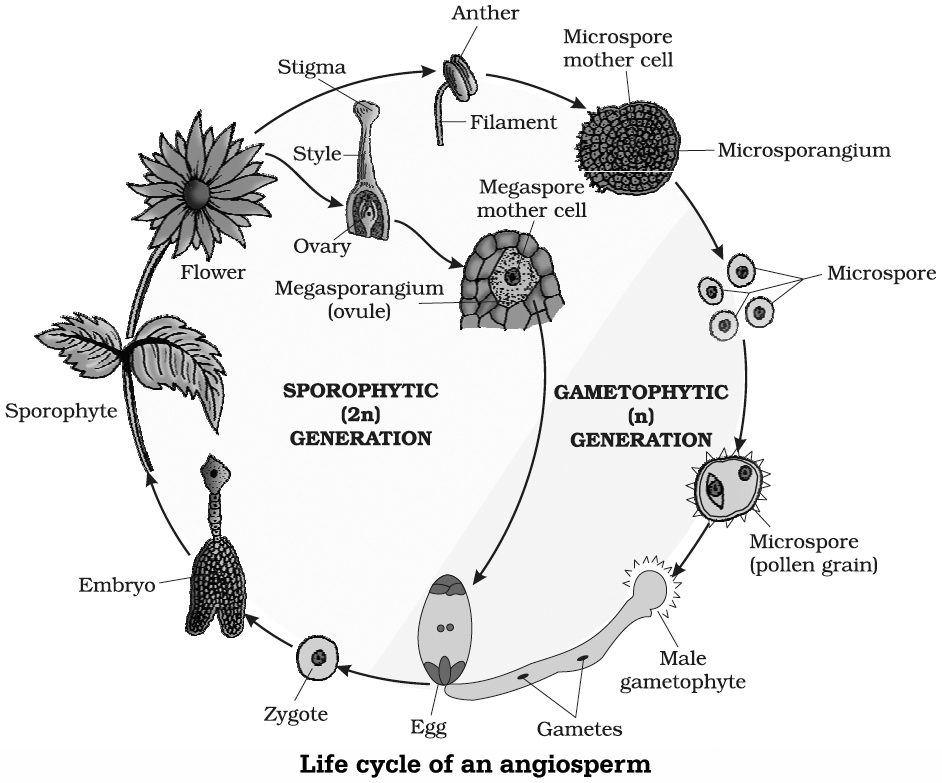
Angiosperms are those seed plants in which ovules and seeds are covered (inside fruits) and the sporophylls are organised into flowers. These are found in almost all the possible habitats. Tillandsia (Spanish moss) is an epiphytic angiosperm.
General characters
Flowering plants or angiosperms are the most recent and highly evolved plants.
Sporophylls are aggregated in flowers. It is their most striking feature. Therefore, angiosperms are also called flowering plants.
Stamen (male sex organ) consists of a filament and an anther. Carpel (female sex organ) is rolled and partly sterilised to produce a stigma, style and ovary, containing ovules.
Pollination occurs through several agencies, but most prominent amongst them is by animals, especially insects.
Pollen grains or microspores reach stigmatic surface found at the tip of carpel or megasporophyll (indirect pollination).
Female gametophyte or embryo sac is highly reduced and generally develops upto 8-nucleate stage prior to fertilization.
Archegonia are absent. Instead, there is one egg surrounded by two specialised synergid cells that attract the pollen tube. The latter brings two naked non-flagellate male gametes.
There occurs double fertilization . One produces zygote, hence embryo. The other forms primary endosperm cell.
Endosperm is formed through triple fusion and is generally triploid.
Fertilized ovules ripen into seeds. The seeds are covered by ovary wall. A fruit is technically a ripened ovary. Fruits not only protect the seeds but also help in their dispersal.
Xylem contains vessels.
Phloem possesses sieve tubes and companion cells.
Angiosperms are divided into two sub-groups-dicotyledons and monocotyledons, mainly on the basis of number of embryonic leaves or cotyledons. The two are commonly called as dicots and monocots.
Differences between dicots and monocots
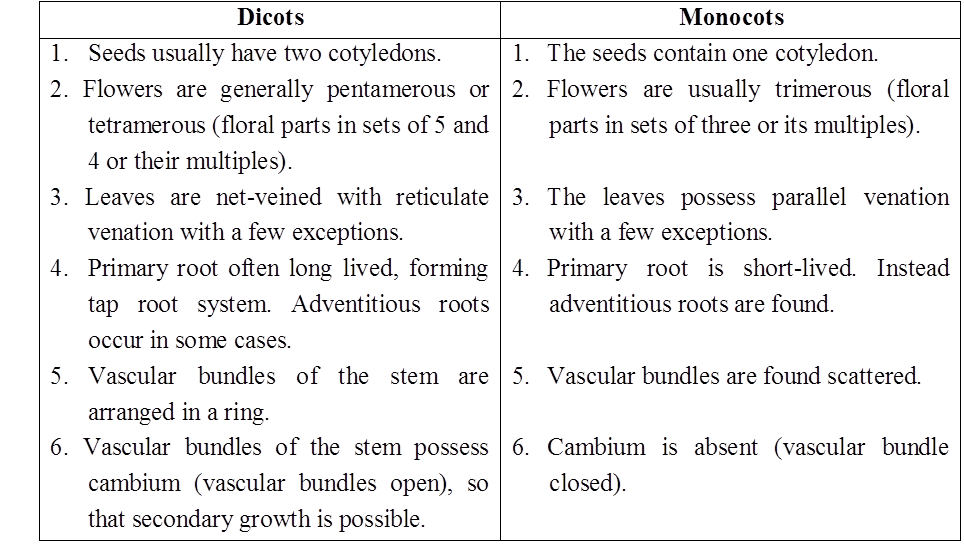
Differences between various plant groups having embryo
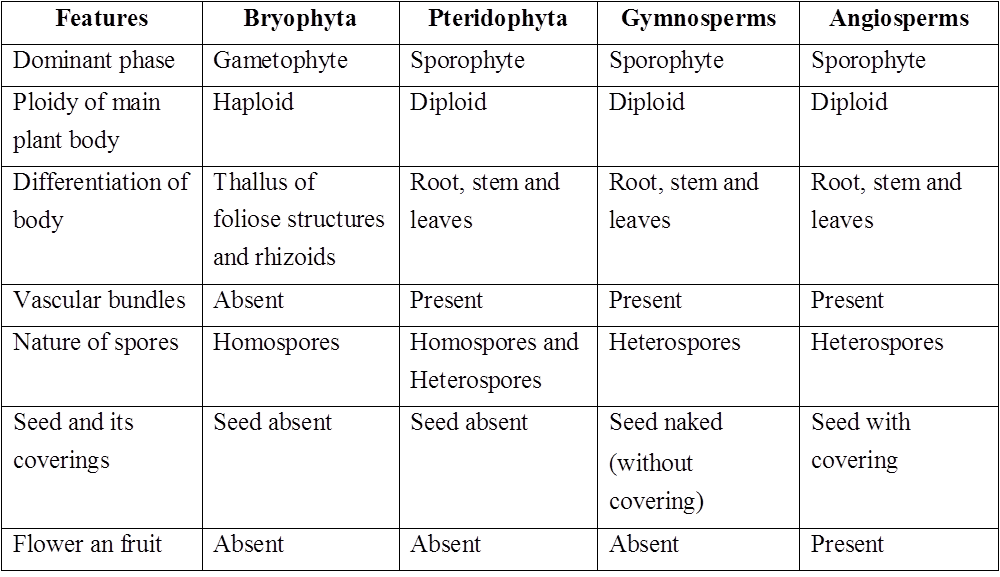
Angiosperms
Angiosperms (flowering plants) generate pollen grains and ovules in specialized structures known as flowers. The seeds of angiosperms are encased in fruits. The angiosperms are a diverse group of plants that can be found in a variety of environments. They range in size from the tiniest Wolffia to massive Eucalyptus trees (over 100 meters). Food, fodder, fuel, medicines, and a variety of other commercially significant things are all provided by them. There are of two types: monocotyledons and dicotyledons. Seeds with two cotyledons, reticulate venations in leaves, and tetramerous or pentamerous flowers (four or five members in each floral whorl) distinguish dicotyledons.
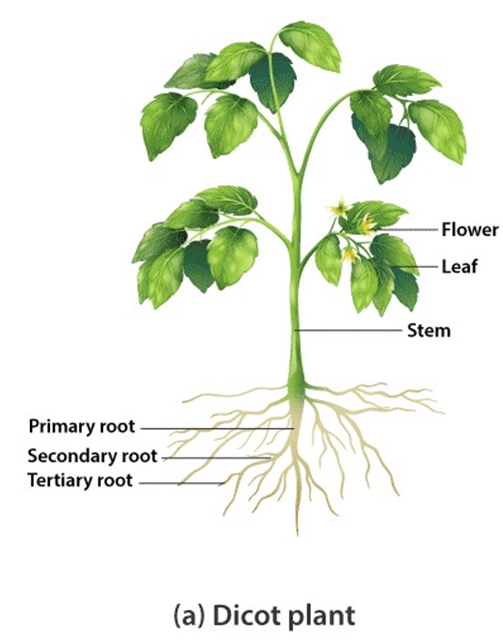
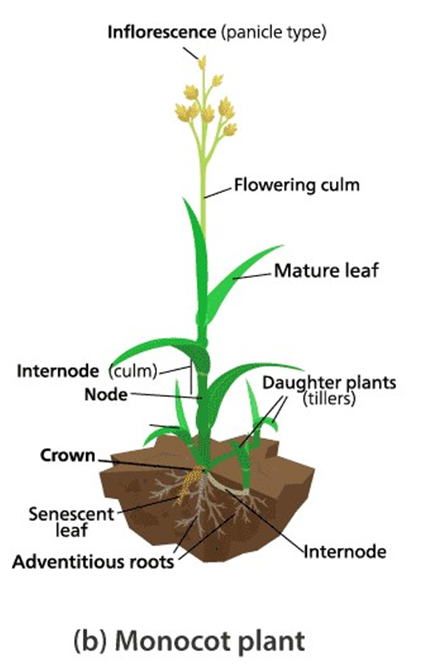
Figure 9: A dicot and monocot plant.
Monocotyledons, on the other hand, have single cotyledonous seeds, leaves with parallel venation, and trimerous flowers with three members in each floral whorl. The stamen is a flower's male sex organ. A short filament with an anther at the tip makes up each stamen. The pollen mother cell divides through meiosis within the anthers to produce microspores, which mature into pollen grains. The pistil is a flower's female sex organ. A large ovary, a long slender style, and the stigma make up the pistil. Ovules can be found inside the ovary. Each ovule has a megaspore mother cell, which goes through meiosis to produce four haploid megaspores. To produce the embryo sac, three of them degenerate and one divides.
A three-celled egg apparatus – one egg cell and two synergids, three antipodal cells, and two polar nuclei – is found in each embryo sac. Eventually, the polar nuclei combine to form a diploid secondary nucleus. Pollen grains are dispersed from the anthers and carried to the stigma of a pistil by wind or other means. Pollination is the word for this process. The pollen grains germinate on the stigma, and the pollen tubes grow through the stigma and style tissues to reach the ovule. Two male gametes are released from the pollen tubes into the embryo sac. Syngamy occurs when one of the male gametes combines with an egg cell to generate a zygote. The triploid primary endosperm nucleus (PEN) is formed when the other male gamete combines with the diploid secondary nucleus.
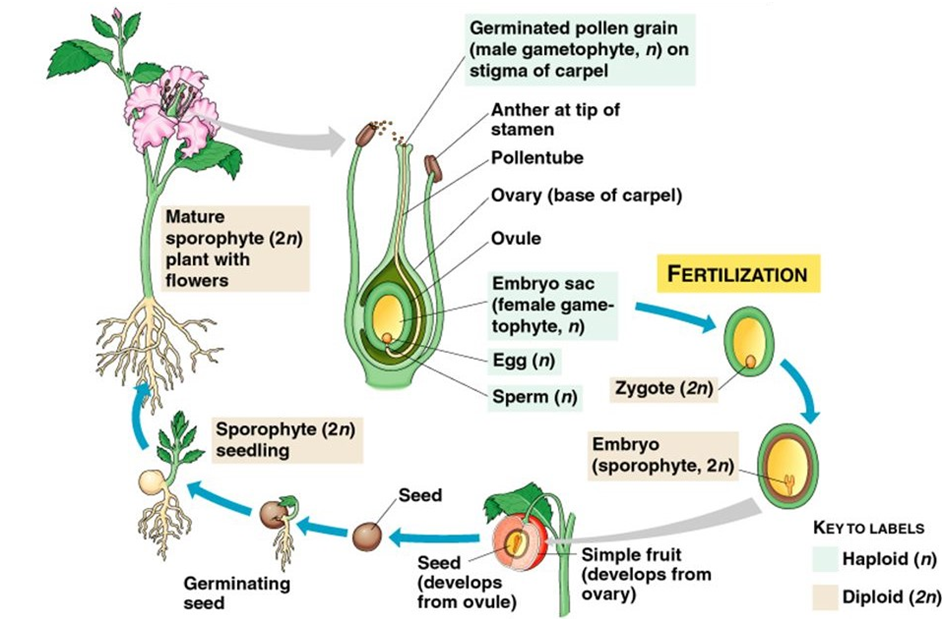
This phenomenon is known as double fertilization because it involves two fusions, syngamy and triple fusion, which is unique to angiosperms. The zygote matures into an embryo (with one or two cotyledons), and the PEN matures into endosperm, which feeds the growing embryo. After fertilization, the synergids and antipodals disintegrate. The ovules become seeds, and the ovaries become fruit, during these activities.

 ACME SMART PUBLICATION
ACME SMART PUBLICATION
